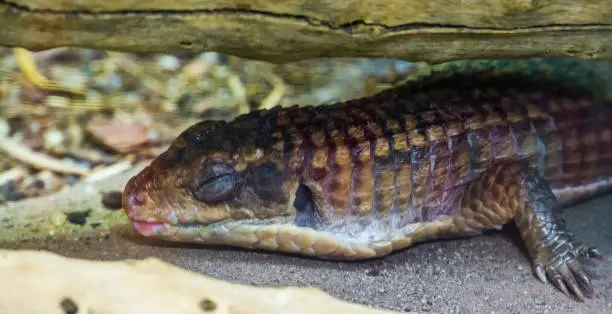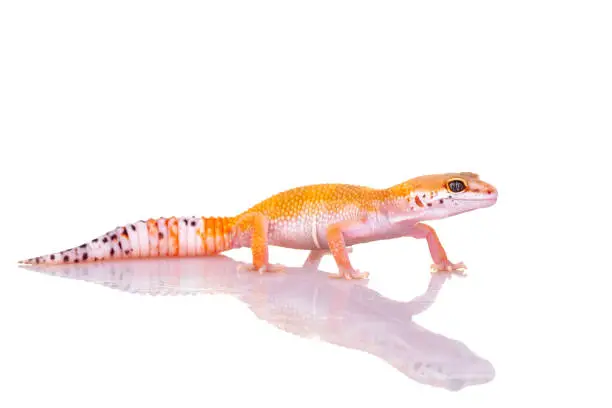How long can your Leopard Gecko survive without a heat lamp? Your Leopard Gecko may be able to survive up to one month without heat, provided the temperatures are within the normal range of 60° Fahrenheit (15° C). In this article, you will learn all about the natural Leo adaptation and reactions to low temperatures, health risks of low temperatures, what to do in the inevitable event of low temperature in Leo’s habitat, and how to best prepare.
In this article
How Long Can Leopard Geckos Go Without Heat?
Lizards like your Leopard Gecko’s body temperature depends on their surrounding environment. They are cold-blooded, and they need external heat to survive because they cannot generate their body heat like mammals (warm-blooded animals) and birds can. That is why we recommend providing a warm side and a cool side in your lizard’s habitat.
A Leopard Gecko should ideally live in a temperature range of 75-80°F on the cool side and 80-85°F on the warm side. The ideal basking area temperature between 90-95°F will be sufficient.
Extreme variance out of these ranges puts life-supporting systems like digestion and the immune system of your gecko in jeopardy. This explains why leopard geckos that have been left in the cold without adequate heat sources will develop serious health issues and even die if no corrective measure is taken.
But I have more to share with you. Leopard Geckos can go through adverse environments. When bad weather reigns, they are very adaptable and swiftly transition into brumation.
Brumation for Survival.
What is Brumation?

Just as animals hibernate, brumation is a period of dormancy in reptiles during drastic climate change, especially in winter. This is a natural tendency in reptiles when the temperature drops for an extended period. A leopard gecko survives off of the fat stored in its tail when this occurs.
During brumation, reptiles slow down and eventually shut their bodies to conserve energy where they do not move as often, stop defecating, do not drink, or eat for a number of weeks. Reptiles don’t respond to normal stimuli like prodding and poking during this season.
It is common for brumating reptiles to migrate into underground burrows or move to the darkest parts of their habitat as a measure of staying away from predators within this vulnerable period.
If temperatures don’t drop below 60°F (15°C), the geckos should be able to live for one month without their heat source.
You don’t have to let your new pet become another dead giveaway in your home, though. Even though a Leopardo Gecko might be able to live for about a month without a proper heat source, this is dangerous for the gecko and can lead to serious health issues, so never try this at home.
Potential Health Risks when Leopard Gecko stays without heat.
As we mentioned before, Leopard Geckos are cold-blooded, and they need an external heat source to warm up their bodies and perform essential life-supporting boy functions.
Most lizards don’t survive the winter if exposed to extreme cold. A cold gecko’s body can’t function properly because its metabolism shuts down. This causes all sorts of problems, including digestion, a weakened immune system, and other serious illnesses.
In this section, we’ll look at the health issues that might occur to your Leopard Gecko if he’s exposed to cold temperatures for a long time.
Respiratory Infection
A common health problem caused to your Leopard gecko by extended exposure to cold temperatures is respiratory infections. Contact your reptile vet immediately if you notice any of the following symptoms: lethargy, clogged nostrils, breathing with an open mouth, bubbly saliva, lack of appetite, and weight loss.
A combination of antibiotics and probiotics, plus extra hydration and feeding assistance, are required for respiratory infections.
Stick Tail Disease
Tails are fat stores for Leopard Geckos, and when they are in brumation, they are forced to live off their tail’s fat stores since they cannot eat or digest food without heat.

Geckos have large, thick-skinned, leathery tails that help them store fat. When cold temperatures force them to hibernate in winter, they exclusively live off their tail’s fat stores since they cannot eat or digest food without heat.
Without heat, the fat stored in a lizard’s tail may eventually deplete. The tail will then look like a thin stick.
Impaction
If a Leopard Gecko is exposed to cold temperatures regularly or for an extended period, it may experience impaction.
Impaction is when a gecko has something stuck in its digestive system, in the stomach or intestines. This may occur if the leopard gecko stays in the cold regularly or for too long.
This typically happens when a gecko’s digestive system isn’t working properly due to the cold temperatures.
Impaction is an issue that geckos often face and is a good candidate for home-based treatment. A warm bath and massage of the belly can help the obstruction pass. Or, you may be able to treat it by orally administering a drop of mineral or olive oil to help the obstruction pass.
However, Leopard Geckos showing signs of impaction need to get a vet’s opinion as soon as possible. Especially if you are a first-time keeper.
Preparing Reptiles For Winter’s Sleep
A reptile keeper should always have a backup plan in preparing reptiles for brumation if the situation is inevitable. If you live in extremely cold weather conditions, are prone to power outages, and have reptiles, your Leopard gecko will have your best interests at heart and create a suitable plan.
You can do a few things to prepare for an extended power outage.
Increase Thermostat
You’ll need to increase the cage temperature by 1 to 3 degrees before the power outage and remove the programmed temperature decrease. This will keep the cage warmer for a longer period preceding the anticipated power. Lamps can be left on overnight for even more heat generation.
Back up generator
Consider a generator as an additional power source to be installed to cater for your Leo. If power outages are common occurrences or you need your Leos to be housed separately, a backup generator is necessary.
It is unnecessary to worry about hypothermia if you’re out in a short-term power outage. Being sleepy and having short-term brumation is quite normal in your Leo during times of low temperatures.
If your leopard gecko reacts to stimulus, she is doing well. However, if your Leo is no longer climbing and clinging or is disoriented, you should call your reptile vet for assistance.
Use A Candle Space Heater
There are cases where your leopard gecko will need a warm room, especially when she is sensitive to temperature or unwell. You may want to consider using a candle space heater for your leopard gecko in such a case.
Candle space heaters should be placed in an enclosed room inaccessible to children and other pets. They are the safest method of maintaining heat during a power outage but should be used only when necessary and in an enclosed area that animals or children cannot access.
Move The Cage To A Confined Space
When you shift the cage to a smaller space like a wardrobe or bathroom, it will retain more heat for longer.
Additional Bedding
You can keep the cage warmer just a little bit longer by adding more material to it. It will be possible for your Leo to burrow to regulate the body temperature even better.
Discontinue Feeding
Avoid feeding your leopard gecko 24 hours before a power loss. Food cannot be properly digested when temperatures drop, resulting in severe illness and even death.
A thermometer placed in the room should show the temperature at 60 degrees Fahrenheit or below.
Provide Clean And Replenish Bowls With Water
You’ll want to avail clean water supply if the power goes out and pipes freeze. You might want to keep some water bottles on hand during a power outage and avoid tap water reliance.
Conclusion
Leopard geckos will live without heat for a few days. This is dependent on the temperature being between 60 degrees and 75 degrees Fahrenheit. However, in the event the temperature drops below 60 degrees, it’s a good idea to find a place with heat. If your situation is direr, you can learn how to retain heat by turning to this article.


